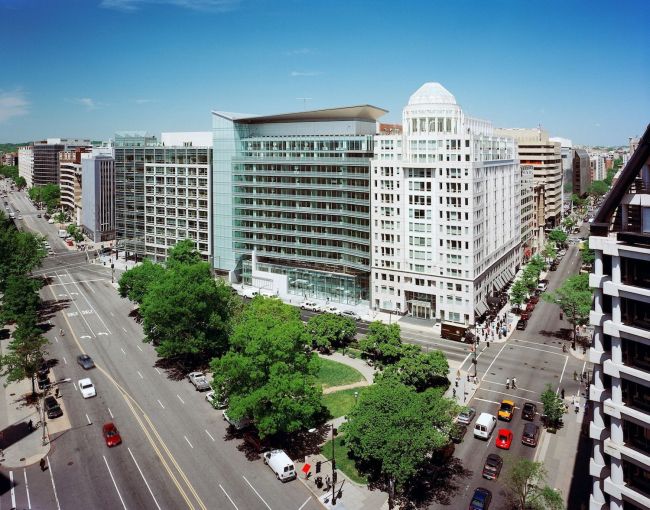Landlords Turning to Creative Dealmaking in DC Office Market
EastBanc tries out new options at 1875 Penn and other D.C. and NYC buildings
By Keith Loria July 29, 2020 10:45 am
reprints
There is a global conversation occurring right now about the future role of the workplace, which will not simply disappear when COVID-19 is under control. That is driving office landlords in Washington D.C. to be proactive in making lease concessions and promoting the benefits of the workplace.
For instance, at the 13-story 1875 Pennsylvania Avenue NW, a 290,000-square-foot, trophy office building which will be vacated in the fall of 2022, owner EastBanc has gotten a bit creative, reducing the transfer cost and rent, allowing for a break clause and a shorter lease.
“We, and our colleagues at Cushman & Wakefield (CWK), have decided to shine a spotlight on the uninflated real value of a lease and property and offer 1875 Penn at a triple-net rental rate of about $29 per square foot, compared to the traditional rate of $65 per square foot which accounts for all the transition costs we could solve for with a first-class building,” Philippe Lanier, principal at EastBanc, told Commercial Observer. “In an uncertain world, we have to create a structure that is flexible and easy. If you can provide a turnkey solution with an easy exit in coworking, why not with trophy properties?”
This structure would have been attractive before COVID but is even more relevant today.
“Before COVID struck, the rental concessions had exceeded tenant’s requirements and were inflating rents and values,” Lanier said. “All we have done is stripped out the fluff and started from the bottom on cost. There is always time when a tenant is ready to plan to finance upgrades to the property and slowly increase rent to pay for it.”
Lanier noted that the outlook is so uncertain that it’s easy to get stuck in place, and actions like this will help the market find momentum again and not be held hostage by an invisible opponent.
“What we have done is taken this period not only to figure out what is needed in any scenario, but how to create flexibility for two parties to pivot when needed so they can move forward with minimum risk,” he said. “With EastBanc, tenants will find a committed landlord who is focused on its tenants’ needs, not our ability to exit. In order to create that flexibility, we need to minimize the money sunk in a transaction, so by reducing concessions, fees, and unnecessary buildouts, we can offer flexibility in term and the lowest carrying cost possible.”
EastBanc has implemented this strategy across several of its properties and is seeing success both in D.C. and in New York.
“Reducing incentives and focusing on low net rent leases with flexible exits has proven effective,” Lanier said. “Through the implementation of this strategy, EastBanc has managed to generate interest in a market where deals are rarely getting done, and in a period of extreme uncertainty.”
While this effort might impair the value of the asset and its ability to carry a loan, it also could reduce its assessed value and the tax burden to both parties, so it has its pros in a period where most companies need to tighten their belts, he said.
“On the flipside, it actually improves occupancy risk since it’s hard for a tenant to leave such an attractive deal unless forced by circumstance,” Lanier said. “This is a tool for a long-term committed owner like EastBanc, which is why we believe it will resonate with our tenants. We are committing to them in an uncertain time. Despite the difficulty for others to compete with us in this regard, we believe that so long as we are faced with uncertainty, an approach like this will be the fastest way to structure a deal that someone can make a decision on.”
Gary Stein, Savills’ vice chairman and co-regional manager for Washington, D.C. noted the core tenant base in the D.C. Metro—government and related entities, law firms, not-for-profits and associations—combined with the growth of the tech industry, provide a resiliency to the region unlike other major markets.
“Office leasing volume in Washington, D.C. totaled 2.1 million square feet in the second quarter, which is just shy of the 5-year quarterly average of 2.2 million square feet, so leasing activity is still healthy,” he told CO. “That said, over half of the completed leases in the second quarter were renewals and 18 percent were short-term extensions. Understandably, companies that need to make upcoming real estate decisions due to a lease expiration may find it challenging to make long-term commitments given the uncertainty surrounding COVID-19.”
Jon Glass, Savills’ corporate managing director for Washington, D.C., added that D.C. has been a tenant-favorable market for more than 10 years and the firm expects to see that continuing and even accelerating for the foreseeable future.
“In fact, concessions—free rent and tenant improvement dollars—are the highest on record of any major U.S. office market, which will continue to increase,” he told CO. “For the months ahead, I anticipate landlords will consider shorter term leases (2-3-year terms or 5-year terms with termination options) as tenants are hesitant to make long-term commitments.”
Glass also anticipates a growing demand for built-out, short-term office space under 8,000 square feet as tenants who are currently in coworking spaces examine their own private suites in order to minimize interaction with other tenants.
Many landlords around D.C. have been focused on enacting a health and wellness plan that enables a safe environment for their office tenants, staff and management. This includes drafting new cleaning procedures, evaluating air and water quality, adopting social distancing measures and ordering appropriate PPE for their buildings.
“This is critical to attracting and retaining tenants,” Stein said. “Landlords are also temporarily restricting access to shared amenities like fitness centers and tenant lounges, while also reducing the seating capacity for shared conference centers.”


